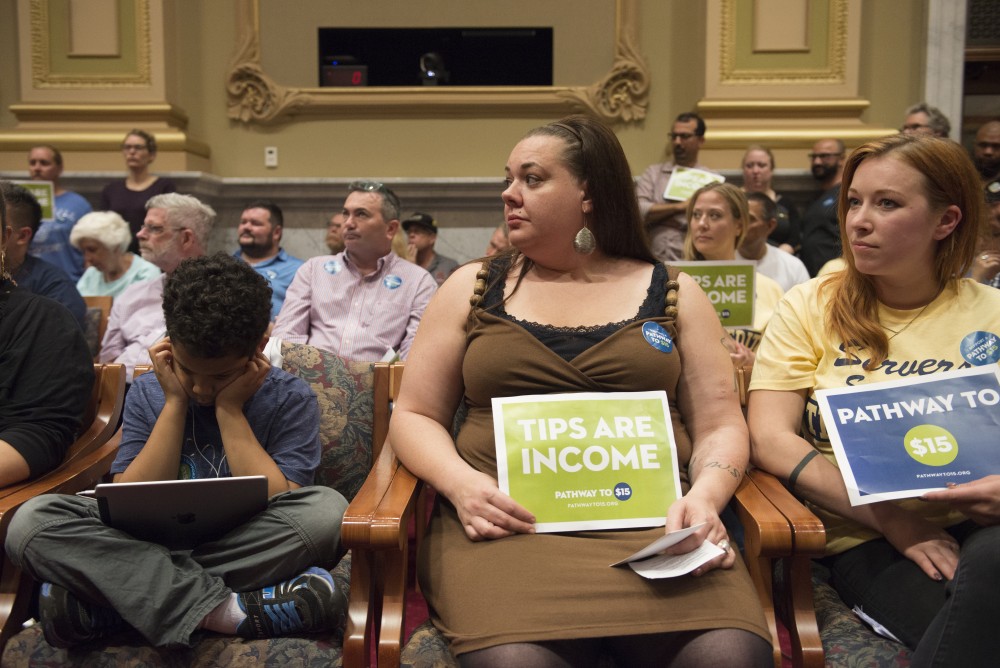A lively crowd packed into Minneapolis City Hall Thursday for a public hearing on the City Council’s proposed $15 hourly minimum wage ordinance.
While the Council and most speakers at the hearing showed strong support for the $15 minimum wage, there were points of contention between how businesses can afford the increase and employees who rely on the wage.
The hearing lasted almost 6 hours as 139 people addressed the Council in two minute speeches. Ward 2 Council Member Cam Gordon said it was one of the longest public hearings since he joined the City Council 11 years ago.
Supporters chanted, “Poverty wages have got to go,” from the hallway and many shared stories of financial hardship at the hearing.
 The ordinance raises the minimum wage to $15 per hour from the state’s wages of $9.50 for large employers with over 100 workers and $7.75 for those with fewer. It would be implemented across five years, with large employers increasing wages by at least $1 annually, until reaching $15 in 2022. Smaller employers would reach $15 in the same year, but in smaller increments.
The ordinance raises the minimum wage to $15 per hour from the state’s wages of $9.50 for large employers with over 100 workers and $7.75 for those with fewer. It would be implemented across five years, with large employers increasing wages by at least $1 annually, until reaching $15 in 2022. Smaller employers would reach $15 in the same year, but in smaller increments.
But some business owners showed concern about how they could afford the increase in the given time frame.
“I believe in $15; I just need to be profitable enough to do it,” said Rod Johnson, owner of Midwest Mountaineering in Cedar Riverside.
Johnson said he started paying his employees at least $10 hourly three years ago, despite stiff competition from large and online retailers.
Working with the proposed five-year timeline would be a struggle, Johnson said, but more time would help.
A 90-day training wage provision, which makes employers pay at least 85 percent of the state’s minimum wage for workers under 20 years old, faced heavy criticism at the hearing.
Bridget Peterson, a University of Minnesota-Morris student, said in an interview the training wage hurts students who rely on summer jobs to help with tuition.
“The training wage would provide incentive for companies, particularly big fast food and retail companies, to cycle through employees, retaining workers for only 90 days,” Peterson said at the hearing.
Gordon said the training wage was meant for certain age groups, but criticism at the hearing made him want to revisit the wording.
“I think it would be lousy if every summer, somebody worked at St. Thomas and they kept getting 85 percent of the minimum wage all four years … because everybody said, ‘Well, you’re still on the training wage,’” Gordon said.
Minnesota state law mandates a youth and a training wage, both at $7.75 per hour.
Several Minneapolis restaurant owners and some tipped employees raised another concern at the hearing: the exclusion of a “tip credit” system in the ordinance.
In a tip credit system, tipped employees make a base hourly wage below the minimum wage due to earnings from tips.
 Proponents of the system said it lets employers give workers more hours. And if tips aren’t enough to meet minimum wage, employers will cover the difference.
Proponents of the system said it lets employers give workers more hours. And if tips aren’t enough to meet minimum wage, employers will cover the difference.
Detractors of this method said at the hearing the difference is vulnerable to clerical errors and theft by employers, calling the “tip credit” a “tip penalty.”
But advocates of the system said the tip credit system is more financially sustainable for businesses, given how much more tipped servers can earn than non-tipped kitchen staff, like cooks.
Jennifer Schellenberg, a tipped employee with 16 years’ experience working in restaurants, said the current city ordinance will stagnate the wages of non-tipped workers.
“Under [the ordinance], the people of the restaurant industry that you intend to help the most, the lowest paid workers, will lose their jobs” she said.
Kelli Dietz, a University of Minnesota psychology graduate working as a server, said she couldn’t find a better-paying job after graduation than serving to pay her $60,000 in debt.
With big change inevitably coming to Minneapolis restaurants, Dietz is facing an uncertain future. “I need to know if I can pay my bills.”






















